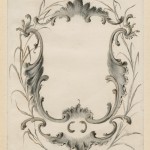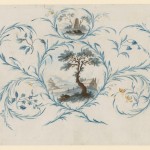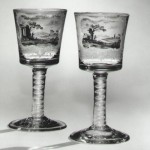![Watercolor for urn and swags within cartouche of grasses by William Beilby, [1765]. Purchased with the Fellows Fund. (CMGL 141704)](http://blog.cmog.org/wp-content/uploads/2015/02/Rakow_1000145284_crop_RGB-apd-300x226.jpg)
Watercolor for urn and swags within cartouche
of grasses by William Beilby, [1765].
Purchased with the Fellows Fund. (CMGL 141704)
William Beilby Jr. (1740-1819), the guiding hand behind the family’s art, is recognized as one of the finest painters on glass of the 18th century. He was also an innovator. Most notably, Beilby developed a process for adding metallic flux to the enameling pigments; this enabled him to better fuse the pigments into the glass. We know from historical accounts of her day that Mary Beilby (1749–1797), a glass painter, was among the first women who were employed as artisans in glass workshops. The rest of the Beilby family were talented artisans. William Beilby Sr. (1706-1765) worked as a silversmith and jeweler. Both he and his wife Mary (1712-1778) saw to the education of their four children: William Jr.; Ralph (1743-1817), a skilled engraver with an expert knowledge of heraldry; and Thomas (1747-1826), a drawer, painter and enameler. Primary sources, most notably the Memoir of Thomas Bewick – an apprentice engraver to Ralph Beilby – tell us all the Beilbys participated in the family business. Still, their individual contributions are a matter of debate and study. Thus, all surviving Beilby works, whether in glass or on paper, are valuable as objects of art but also as primary resources in the study of this prestigious family.
Attributed to William Beilby Jr. and Thomas Beilby, these eight works on paper are Notable Acquisitions acquired in 2014. The pieces date from around 1765 and document two aspects of the Beilbys’ work: their armorial work and William and Thomas’ drawings and paintings on paper. Seven works are cartouche designs featuring images and themes common in the Beilbys’ work on glass: foliate scrolls, ribbons, urns, stylized flowers and foliage. Painted on glass, these cartouches would have framed richly colored heraldry or imagery such as that seen on the armorial goblet below (50.2.8 A).
- Watercolor for cartouche of foliate scroll and rocaille with grasses by William Beilby, [1765]. Purchased with the Fellows Fund. (CMGL 141708)
- Armorial Goblet, Mary and William Beilby, Newcastle upon Tyne, about 1765. 50.2.8 A.
The next piece is a wonderful example of William Jr. and Thomas’ beautiful drawings and watercolors. This watercolor includes four landscape scenes featuring trees, buildings and an obelisk. Each vignette is framed by a cartouche of blue foliage incorporating flowers. Similar vignettes were featured on their glass work, as in the two goblets pictured below (71.2.48). William Jr., who opened a drawing school in 1767, was a master of drawing and known for his work in watercolors.
- Landscape scenes in four vignettes by William Beilby, [1765]. Purchased with the Fellows Fund. (CMGL 141703)
- 2 Goblets, Mary and William Beilby, Newcastle upon Tyne, about 1765-1770. 71.2.48.
The purchase of these works enhances the Rakow Library’s collection of Beilby works on paper. Previously, the Rakow’s collection of Beilby items included two botanical watercolors attributed to Beilby – each signed “W. Beilby” on the reverse – four pen and ink drawings, one watercolor a 1774 William Beilby topographical drawing depicting a man and a donkey on a road in an Italianate landscape. The drawings also complement the Museum’s outstanding collection of Beilby glass.
The purchase of these works was made possible by the generous support of the Fellows of The Corning Museum of Glass.
For more on the Beilbys, see Simon Cottle, “Reports: Fragile Diplomacy: The Significance of the Beilby Royal Armorial Goblets,” Glass Circle News, v. 37, no. 2, July 2014, pp. 22–24; idem, “Beilby Enamelled Glass,” Glass Circle News, v. 34, no. 3 (issue 127), November 2011, pp. 6–11; and James Rush, The Ingenious Beilbys, London: Barrie and Jenkins, 1973.
The Rakow Research Library is open to the public 9am to 5pm every day. We encourage everyone to explore our collections in person or online. If you have questions or need help with your research, please use our Ask a Glass Question service.




